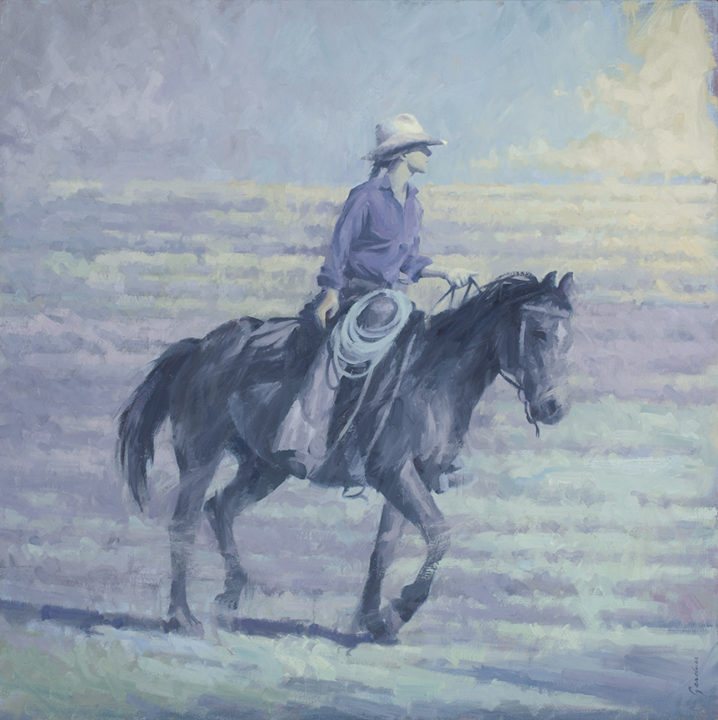The Local newsletter is your free, daily guide to life in Colorado. For locals, by locals.
Over the past two decades, the urban-rural divide has widened in Colorado. It’s reflected in the state’s politics, economics, and cultural contrasts between growing population centers on the Front Range and smaller communities struggling to keep pace. The idea that Colorado is changing—shifting away from its mining and ranching legacy and embracing industries like tech—has been written about at length and is often the focus of political rhetoric in the Centennial State. It’s also been an inspiration for Terry Gardner, the featured artist at this year’s Coors Western Art Exhibit, part of the 113th National Western Stock Show.
Gardner, who moved to Colorado from St. Louis in 1994, has felt a special connection to the West since his boyhood days, when he grew up watching dramas like Gun Smoke, Jeremiah Johnson, and Clint Eastwood thrillers. Early in his career, Gardner was mostly painting landscapes. But then, he says, “I started getting more interested in the history of the West, the various industries in the West… how they started colliding with urban centers.”

For 20 years, Gardner painted at night while raising triplets and juggling an intense advertising career. He always made time for art—this is his 16th year participating in the stock show—but he left the corporate world for good in 2015 to focus on painting full-time. It paid off, as this year he’s being recognized as the stock show’s featured artist, something he considers a “distinguished honor.”
“Over the years, Terry’s work has continued to be strong and to push boundaries with concepts of Western art and also with style and ingenuity,” says Rose Glaser, who has curated the Coors Western Art Exhibit and Sale for the past 23 years. “His work really connects with people and I think it feels Western but has a contemporary edge to it that our audience really likes.”

One factor that has elevated Gardner’s painting is that he doesn’t blindly romanticize the land or the people living on it. Traditional Western culture has endured hardships, and Gardner feels a responsibility to paint an honest portrait of that lifestyle in 2019. “I don’t know if I would feel good if I just painted work trying to glorify the West,” he says. “The West is awesome, and that’s why I think there’s been this expansion for a couple decades now. But I also think people need to be aware of what is happening.”
He makes audiences aware in paintings like “Looking East from Noe Road,” in which two fading homesteads sit side-by-side, rendered in muted colors amidst the rolling hills near Larkspur. A satellite dish extends from the roof of one house and a propane tank sits behind it. In the background, an SUV speeds by on I-25, “blind to the impact [it] is having along the Front Range,” according to Gardner. He notes that fading homesteads like these are “often overlooked as developments and roads move in to accommodate the growing population.”
His focus on fading homesteads is one of the reasons he was selected as the featured artist, according to Glaser. “His work subtly comments on how we’re losing some of those things that should be kind of precious to us,” she says.

Gardner admits that some of his art, while inspired by nostalgia for Western culture, might be viewed as melancholic or even a little bit dark. In “Where do We Go From Here,” he paints a cowboy on horseback gazing into the horizon and seeing “uncertainty.” He says that cowboy is “the portal into topics facing all of us—from population growth, water usage, conservation, careers in ranching, and more.”
But some of his work strikes a hopeful note, too. “The Purple Rider,” which is featured on the show’s promotional posters and will be included in the permanent collection of the stock show, is a nod to the emergence of influential women in 2018, Gardner says. Depicting a young cowgirl named Samantha, the painting was developed with a better future in mind. The subject of the painting is “hard-working, driven, and confident in the recent elections [in which] Americans acknowledged her presence with votes and the hope of bridging the gap between red and blue,” he says. “The Purple Rider is the face of the future.”

The show had never before featured in its permanent collection a piece of work with a cowgirl or female rancher as the subject. When Gardner brought this to Glaser’s attention, she was thrilled. “We have a pretty cool state. We have some tough-ass women,” she says. “We always have. I love that ‘The Purple Rider’ is [now] in our collection.”
As the show opens to the public on January 12, Gardner hopes that people who view his art understand he’s trying to address issues facing the West, and that there’s something deeper at work. “There have been a lot of great paintings of cowboys and cowgirls. But what is the relevant subject?” he asks. “It’s important that we as artists reflect what is going on socially, culturally, and politically.”
If You Go: The Coors Western Art Exhibit and Sale will run throughout the duration of the 2019 National Western Stock Show, January 12 to 27.








